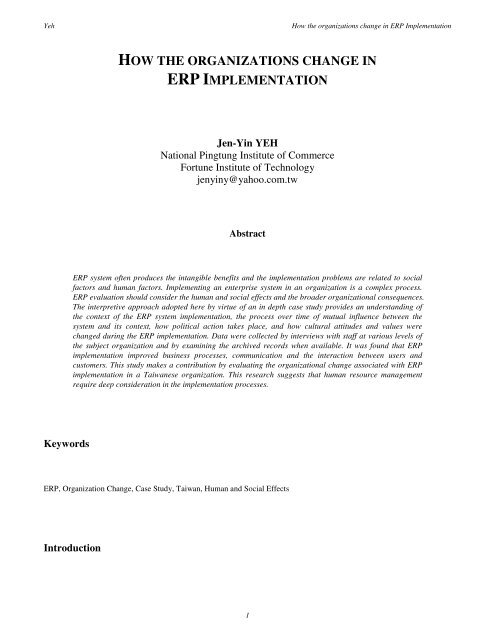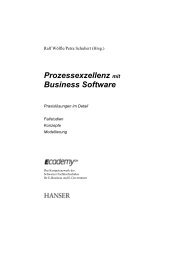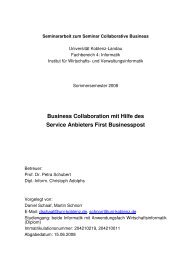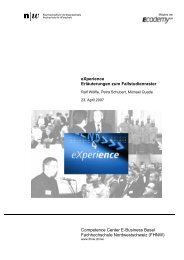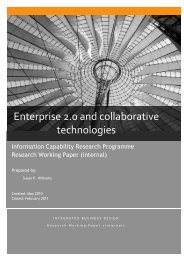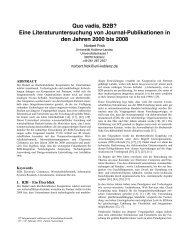HOW THE ORGANIZATIONS CHANGE IN ERP IMPLEMENTATION
HOW THE ORGANIZATIONS CHANGE IN ERP IMPLEMENTATION
HOW THE ORGANIZATIONS CHANGE IN ERP IMPLEMENTATION
You also want an ePaper? Increase the reach of your titles
YUMPU automatically turns print PDFs into web optimized ePapers that Google loves.
YehHow the organizations change in <strong>ERP</strong> Implementation<strong>HOW</strong> <strong>THE</strong> <strong>ORGANIZATIONS</strong> <strong>CHANGE</strong> <strong>IN</strong><strong>ERP</strong> <strong>IMPLEMENTATION</strong>Jen-Yin YEHNational Pingtung Institute of CommerceFortune Institute of Technologyjenyiny@yahoo.com.twAbstract<strong>ERP</strong> system often produces the intangible benefits and the implementation problems are related to socialfactors and human factors. Implementing an enterprise system in an organization is a complex process.<strong>ERP</strong> evaluation should consider the human and social effects and the broader organizational consequences.The interpretive approach adopted here by virtue of an in depth case study provides an understanding ofthe context of the <strong>ERP</strong> system implementation, the process over time of mutual influence between thesystem and its context, how political action takes place, and how cultural attitudes and values werechanged during the <strong>ERP</strong> implementation. Data were collected by interviews with staff at various levels ofthe subject organization and by examining the archived records when available. It was found that <strong>ERP</strong>implementation improved business processes, communication and the interaction between users andcustomers. This study makes a contribution by evaluating the organizational change associated with <strong>ERP</strong>implementation in a Taiwanese organization. This research suggests that human resource managementrequire deep consideration in the implementation processes.Keywords<strong>ERP</strong>, Organization Change, Case Study, Taiwan, Human and Social EffectsIntroduction1
YehHow the organizations change in <strong>ERP</strong> ImplementationThe Factors Affecting <strong>ERP</strong> ImplementationCompanies began to adopt enterprise resources planning systems (<strong>ERP</strong>s) to integrate various organizational functions duringthe 1990s. A number of potential explanations for <strong>ERP</strong> implementation failures have been offered and these may broadly beclassified as human/organizational (e.g. a lack of strong and committed leadership), technical (e.g. problems in softwarecustomization and testing, and lack of technically knowledgeable staff), and economic (e.g. lack of economic planning andjustification) (Sarker and Lee, 2003). In more recent years an increasing emphasis has been given to the importance of thehuman factors, over technical and economic factors, as being critical to the success of <strong>ERP</strong> projects (Nah, Lau and Kuang,2001; Wang and Chen, 2005).One frequently noted shortcoming in the management of many projects has been that organizations underestimate the amountof commitment and effort required for the project, and this translates into inadequate time and resources for design, testingand change management (Girard and Farmer, 1998). The most common problems in <strong>ERP</strong> implementation have centered onnetworking issues, knowing when to allow users to modify the packaged software and user training. The main hurdle facedby all the companies has been resistance to change. Employees are often either reluctant to learn new techniques, or the ITdepartment is reluctant to change due to attachment to its existing product. The human and organizational change aspects,and resistance to these changes is inevitable (Gowigati and Grenier, 2001). Hence, some researchers regard that humanfactors, more than technical or economic, are critical to the success of <strong>ERP</strong> projects (Nah, et al., 2001; Alvarez and Urla,2002).The importance of human factors makes good sense in hindsight. <strong>ERP</strong> implementations involve broader organizationaltransformation processes involving business processes, with significant implications for the organization’s managementmodel, organization structure, management style and culture, and particularly for people (Wood and Caldas, 2001,Pawlowskei et al., 1999). The often massive organizational change involved in <strong>ERP</strong> implementation results from the shift ina business design from a fragmented, function-based organization structure to a process one served by an integrated system(Davenport, 1998; Dechow and Mouritsen, 2005).Information System EvaluationMost of the literatures on information system evaluation are quantitative process of calculating the preferred choice andevaluating the likely cost/benefit on the basic of clearly defined criteria. Given a review of the literature on IS evaluation, it issuggested that various issues have generated the need for new directions on IS evaluation. It seems that that IS evaluationrequires a richer examination of the organizational situation than has traditionally been made (Serafei, Smidis and Smithson,1998; Symons, 1990; Walsham, 1995). Researchers have also argued that the IS evaluation process and content are closelyintertwined with each other and also with the context of the organizational change associated with the development andintroduction of a new information system. IS evaluation approaches are needed to support a richer examination of theseintangible aspects, particularly socio-technical issues.Walsham and Waema (1994) designed a framework specifically for understanding organization change associated withcomputer-based information systems. The first component of the framework is about ‘content’. Content includes plannedchanges to products and services, business processes, formal organization structures and roles, and human perceptions. Thesecond main component in the analytical framework is the social context. This includes the social relations betweenparticipants concerned with the information system, the social infrastructure available or necessary for its support, and thehistory of previous commitments made in connection with computer-based systems. The third component of the frameworkis concerned with social processes, and involves taking both a cultural and a political perspective. The cultural perspectiveemphasizes how the information system is related to the maintenance and change of subcultures, the interaction at theboundaries between subcultures, and the multiple meanings ascribed by different groups to the same events and actions. Thiscan be contrasted with the political perspective which emphasizes that surrounding the implementation of the information2
YehHow the organizations change in <strong>ERP</strong> Implementationsystem are processes of control and domination, as well as purported moral issues such as the quality of work life, and havinga part to play in the dynamics of managing the balance between autonomy and control in the organization.Research ObjectivesImplementing an <strong>ERP</strong> system is deeply interconnected with organizational change, and, for the lifetime of the system, itremains a large part of the organization’s formalized internal framework. Within such a context, evaluation should beperformed continuously, combined with process reviews and organizational development which aims to obtain the desiredalignment and fit over time (Hedman & Borell, 2004). The evaluation may relate to the social, political, economicenvironments in which an organization operates and/or the organizational and cultural characteristics, related methodologiesand processes (Serafeimidis and Smithson, 1999). <strong>ERP</strong> systems impose their own logic on a company’s strategy, culture, andorganization (Davenport, 1999). For many organizations, implementing <strong>ERP</strong> means moving from a confederation of looselycoupled systems to a tightly coupled one (Gattiker and Goodhueb, 2004). Managers as well as scientists in many casesattribute the problems associated with the development and implementation of <strong>ERP</strong> to aspects of organizational culture.Some researches studied how management information systems influence the organizational culture (Robey and Azevedo,1994; Daily et al., 1996; Hibbard, 1998; Newman and Chaharbaghi, 1998; Olson, 1982). These studies also suggest that thereis indeed a dyadic relationship between management information systems and organizational culture. And other researchfocuses on this dyadic relationship and identifies the need to understand organizational culture and to manipulate it to supportthe implementation of management information systems through cultural change programs (Avison and Myers, 1995; Claveret al., 2001, Umit, 2006).In summary, it suggested that <strong>ERP</strong> systems have the potential for a significantly positive impact on the overall performanceof an organization. This study attempts to explore the organizational changes associated with an <strong>ERP</strong> implementation in aTaiwanese organization through the conduct of an in-depth case study. This study is to understand the context of the <strong>ERP</strong>system implementation the process over time of mutual influence between the system and its context to answer the followingspecific questions, as shown in following:1. How and why political actions take place?2. How cultural attitudes and values are maintained and changed over time?MethodsCase StudyCase study research is the most common qualitative method used in information systems (Orlikowski and Baroudi, 1991;Alavi and Carlson, 1992) also suggest that the case study research method is particularly well-suited to IS research, since theobject is the study of information systems in organizations, and "interest has shifted to organizational rather than technicalissues". An in-depth case study can aim to understand the context of the information system and the process over time ofmutual influence between the system and its context.3
YehHow the organizations change in <strong>ERP</strong> ImplementationData Collection<strong>ERP</strong> systems are and have been designed to solve the fragmentation of information, particularly in large corporateorganizations (McAdam and Galloway, 2005). Here, the selected case study organization was considered appropriate becauseof its size and hence presumed complexity in terms of potential issues. The <strong>ERP</strong> implementation cost for the caseorganization was $15 million USD. It was touted as the biggest IT project since 2000 in Taiwan and the implementationperiod was particularly long. It was judged that the case was therefore both significant in scale and in terms of complexityand hence potentially a rich source of data. For commercial reasons, the original identity of the company is concealed and isreferred to as “Shine” in this paper.Both primary and secondary data was collected over a four-year period between 2000 and 2004 and was used in writing thecase study. The primary information source was via semi-structured interviews, mostly face to face, but including severaltelephone and email communications. Initially, interviewees were selected from different hierarchical levels including seniormanagers, managers, end users, and project team members, and across different business functions (MIS department,production department, accounting department, and human resource department). All interviewees were asked who else intheir organization could provide insight into the success of the <strong>ERP</strong> implementation. Hence, the sampling approach could becharacterized as consistent with a “snowing ball sampling technique” (Knoke and Kuklinski, 1982).Interviews were typically two hours or so in length and some <strong>ERP</strong> project team members were interviewed more than once toclarify and discuss aspects of the project as they progressed. Most of the interviews were taped-recorded and subsequentlysummarized and transcribed. Other sources of data included documentary evidence: corporate annual reports, organizationalcharts, system training manuals, design documents, and internal correspondence about the system and company web-site data.As well, searches were made of published materials about the company in newspapers and magazines.Data AnalysisThe study attempted to gain a deeper understanding of the context of the <strong>ERP</strong> system implementation, the process over timeof mutual influence between the system and its context, the political ramifications of the process, and how cultural attitudesand values were of relevance throughout the <strong>ERP</strong> implementation. The theoretical framework developed by Walsham andWaema (1994) was used to describe the case and provide a basis for the presentation of a broader analysis on <strong>ERP</strong>implementation.Data was analyzed through the use of qualitative analysis techniques. Tapes from interviews were transcribed and theserepeatedly scrutinized on an issue by issue basis. They were supplemented by notes taken during interviews. As describedabove this allowed the data collected from the various sources to be coded to identify important content, context, and processelements of <strong>ERP</strong> evaluation and implementation in two periods.A combination of historical reconstruction and longitudinal analysis was used to interpret events and actions over a period ofa number of years. The interview data were collected over 3 years from 2002 to 2004. Thus many interviews also focused onevents that could have taken place one or two years before the interviews. The paper does not claim to present how “thingsreally went” but rather to address issues of organization changes associated with the <strong>ERP</strong> implementation.4
YehHow the organizations change in <strong>ERP</strong> ImplementationIntervieweeTable 1 A Summary Direct Contact Data CollectionNumber of people in thiscategoryNumber of formal interviews(1) Senior managers 3 4 1(2) Project managers 2 4 1(3) MIS manager 1 2 2(4) Module leaders 1 2 2(5) Production manager 1 2 5(6) Accounting manager 1 2 0(7) HR manager 1 1 3(8) Project members 2 3 6Number of informal Interviews(including telephone interviewsand e-mail changes)Case Study and AnalysisThis section contains a description and analysis of the case organization, presented using the Walsham and Waema (1994)framework. Background material describing the history of the case company in the 2000s within the context of the majorchanges in the semiconductor industry prior to and during that period is provided for the purposes of contextual orientation.In so doing, events are structured around the two main leadership periods of the project. The first of these periods was underthe first project leader – Dr. Fen (pseudonym) and the second project leader – May (pseudonym).Review of Events and ActionsPrior to the implementation of its <strong>ERP</strong>, Shine carried out its operations with several information systems like MaterialRequirements Planning (MRP). Each system worked efficiently, and was flexible, and friendly to individual functionaldepartments, but overall there was little integration. The lack of integration became an increasingly important issue withdevelopment from a local company to a global company. Recognizing the limitations of its legacy systems, Shine began toinvestigate <strong>ERP</strong> options in 2000. Dr. Fen was appointed to the <strong>ERP</strong> project. He was highly informed on informationtechnology and change management and had successfully introduced two <strong>ERP</strong> projects previously. Although Dr. Fen wasprofessionally very competent in terms of IT systems, he was, unfortunately, not totally conversant with Shine’s culture and,being new to the company, had an imperfect knowledge of the organizations business processes; and hence what wasrequired in the future. Without appropriate resources it was impossible to even scope the overall project. Furthermore, seniormanagers began to express doubts in the project overall and in its conduct. Dr. Fen left Shine in February 2003. The processof implementation was already troubled and in March 2003, a new project manager, May, was appointed. May was anin-house appointment having previously been Assistant to the CEO. Her style was to aggressively pursue the projectblueprint and she quickly gained the support and trust from managers most relevant to the project. She raised in theorganization an explicit understanding of the importance of the project and built up operational mechanisms to fulfill thepotential of the project. A go-live date was originally set for September 2003 but due to quality concerns, system scope5
YehHow the organizations change in <strong>ERP</strong> Implementationconcerns (legacy system integration), business concerns (the busy season), training concerns (head count of end users wasover 300) and other requirements, the “go- live” date was delayed to January 2004.Content – First PeriodThough the project started in 2000, during 2000-2002, the project team struggled in terms of achieving a competitiveadvantage and the development of a good business model. Dr. Fen’s information system strategies were globalization andcentralization. He developed a five year plan for Shine’s group information system. He attempted to establish a core andcorporate business process. Lacking solid organizational support, Fen was forced to compromise the ideal and rather thanreengineer and completely redesign the process, he opted for a more gradual improvement approach.However, the vision or the ‘to-be’ component of the approach was always problematic for Fen to deal with. Basically the‘to–be’ position was dependent on the top management’s vision. Unfortunately their vision was different to that held by Fen.Importantly, top management was responding to a general trend in the semiconductor industry towards declining prices forproducts and services of a given technology over time So, due to the characteristics short cycle time in the industry, topmanagers were understandably eager for short term profits.Social Process under Dr. FenThis section analysis involves cultural and political perspectives on the process of organizational change associated with theimplementation of the <strong>ERP</strong> system.Cultural PerspectiveTo enable its turnkey strategy, which consisted of the integrated packaging, testing, and shipment of semiconductors toend-users designated by the customers, Shine started to centralize its administration departments and information systems in1999. Shine defined the <strong>ERP</strong> project as “GRP” for “Group Resources Planning”. Then, the implementation of the <strong>ERP</strong>system demanded new methods of designing tasks, jobs and work modules and led to new work structures and procedures.Both sites provided their requirements in business process design, but the requirements were often perceived to be in conflict.As well as inter-site conflict, there was interdepartmental functional conflict in regard to the necessary requirements. Due to alack of business transaction and system understanding, there were ongoing difficulties in cross-departmental communication.Further, the various functional managers retained an ignorance of the impact of the project. In fact, they preferred to remainlargely ignorant of the project altogether and to focus on short term accountability goals. Accordingly, they rejected the6
YehHow the organizations change in <strong>ERP</strong> Implementationnotion of the change to current processes. Each essentially wanted customization of the status quo for their function andmaintained that position at all costs. The project was recognized by team members as lacking senior support. This gave rise todoubts about the project’s prospects:“We heard the project will be cancelled.“ [Project team member]Political PerspectiveThe politics surrounding the project were multifaceted and generally disruptive. Because of the rapidly changing demands ofthe semi-conductor industry, Shine also needed to retain flexibility, including flexibility of structure. From Shine’sperspective this was flexibility, from the consultants it was more like instability. Likewise, the project ownership was unclear.Although of obviously strategic significance and operationally important, the project was originally seen as an MIS project. Itwas not until 2001 that users received a clear message from the top management that they “must do it”. Even then seniormanagers preferred to disregard the project.“Most functional managers just wait and see. They do not think GRP will be successfully implemented.” [Project teammembers]Dr. Fen lacked the authority to mandate action. His substantive level was only equivalent to that of other functional directors.The lack of cooperation from other directors related to the ownership and the basis on which they were likely to be rewarded.The GRP project was seen as just an IT project and the various directors did not envision that their support of the GRPproject could improve their department’s performance.“<strong>ERP</strong> is your project. I am doing you favor, if I support you.” [Director of Manufacture department]Even attempts to communicate the project became politicized. For example, the weekly formal meetings were undermined.Dr. Fen was not familiar with Shine’s culture and conflict of authority. Unwittingly he became embroiled in a power struggle.The politics resulted in poor communication about almost every aspect of the project when Dr. Fen was heading it. There wasconsiderable dissatisfaction with Dr. Fen’s leadership.“Shine’s organization is complicated. We need a project manager to coordinate different functional departments and resolvethe conflicts.” “<strong>ERP</strong> is an organization change project, not an IT project. You need to let your users understand the projectimpact. Unfortunately our project manager was afraid of users’ resistance and ran the project in a black box.” [MISdirector]Content - March 2003 ~ July 2004When Dr. Fen left, there was little enthusiasm among the existing management cadre to take on the GRP project. May wasassigned to the project.“Why May? She is from the pricing department. She understood the business operation processes. Being the CEO’s assistant,she is clear about the company vision and strategy. She knows what the top managers want. She has the full support of theCEO.” [Administration manager]In contrast to Dr. Fen’s change management strategy, May focused on project management. She made the project acompetitive imperative. Meeting the ‘go-live’ date was her driving target. She made a lot changes and in the first instance7
YehHow the organizations change in <strong>ERP</strong> Implementationrestructured the project team. She applied project management approaches in the <strong>ERP</strong> project: to its time management,human resources management, resources management, and quality management. She reviewed the coding status and broughttogether internal and external expertise including IT members and consultants. She changed the method of communication interms of frequency, directness when necessary and by supported face to face contacted with daily progress status reports. Herleadership role was acknowledged, at least by some.“She is much better. The most important thing is that she defined the project scope.” “She can resolve the conflicts betweenthe departments.” [MIS director]In terms of her motivational ability the following sentiment was expressed:”A project manger’s strategy affects project team members’ determination. Though the team members in the second periodwere junior they were filled with ambitions.” [MIS manager]Although there were some problems immediately after the implementation, May thought the <strong>ERP</strong> project was successful bythe end of the research period in 2004.Social Process under MayCulture Perspective under MayThe project process was affected by the social climate of the <strong>ERP</strong> project team. May’s reflection on the social climate on herarrival is described below:“When I came to the GRP project office, I felt the atmosphere was strange. “Too quiet” A project office should be filled withsounds. They needed communication and discussion directly, but at that time their communication channel was via e-mail.E-mail is the worst communication tool. It doesn’t present feeling.”May was aggressive and ambitious. She defined her role as “a manager and a communicator “in this project.“Most process improvements were designed before I took over this project. My duty was to focus on human resourcesmanagement. I was responsible for communicating to the owner directors to push end users training. IT professionalknowledge is not so important on <strong>ERP</strong> projects. Communication is more important. You need to convince users to accept it.”Again according to May (with some pride), four fundamental human resource management approaches were used to changethe project team culture - appoint the right people, put them in the right positions, encourage them to work effectively andbuild work team.“We built up the cooperation tacit understanding and a revolutionary sentiment in our project team.”However, a somewhat depressed module leader provided an opposing perspective which reflected an enduring expectationthat the <strong>ERP</strong> was a temporary phenomenon and doomed to failure. Even though the <strong>ERP</strong> system has been fully implementedfor a few months; some users asked when the company will give up the system.Political perspective under May8
YehHow the organizations change in <strong>ERP</strong> ImplementationMay managed to achieve ‘real authority’. She achieved communication between <strong>ERP</strong> project team and functionaldepartments. To some extent she did this by referent authority. She nominated the CEO as the project leader and the CEOcontributed by regularly joining meetings with function directors. May’s summation of this was:“Most directors are at a higher level in the organization structure than me. It is difficult to drive them unless you get fullysupport from the top manager.”An indirect outcome of the <strong>ERP</strong> project and the involvement of the CEO was the modification of the structure of theorganization and the replacement of some senior managers.The project module leaders and some project team members received promotions and salary increases after the <strong>ERP</strong> systemwas deemed to be successfully implemented. At other levels different responses and outcomes occurred. Most IT membersstayed in the team for the other site’s projects. Key users went back to their original function departments. However, a lot ofproject members had already left Shine during the implementation process. This may have been because Shine didn’tannounce any transition process plan for the project team members post the implementation period. As a result, staffseconded to the project felt insecure:“I already left my department for a long time. Someone took over my work. I am not sure if I can go back to my originalposition or not.” [Project team member]<strong>ERP</strong> implementation required some business processes to be changed. <strong>ERP</strong> implementation also reflected that some seniormanagers were not qualified for the current positions. Hence, Shine still continued process improvements and organizationrestructuring after the <strong>ERP</strong> system went -live.Table 2 Content and Process in ShineShine under Dr. Fen 2000- February 2002 Shine under May March 2002-2004ContextContextManagement solution instead of technical solution and BPIinstead of BPRDr. Fen focused on business Process optimization more than<strong>ERP</strong> implementation.Process1. CultureDifferent perspectives on the subculture existed in differentsites and different departments of ShineMost <strong>ERP</strong> project team members were young and junior in theorganization structureDue to a lack of business and system understanding, there wereongoing difficulties in cross -departmental communication.The function managers preferred to remain largely ignorant ofthe project altogether and to focus on short term accountabilitygoals.May focused on project management. She made the projecta competitive imperative.She changed the method of communication in terms offrequency, directness when necessary and by supportedface to face contacted with daily progress status.Four fundamental human resources managementapproaches were used to change the project team culture -appoint the right persons, put them in right positions,encourage them work effectively and build the work team.Process1. CultureThe territorial wars were between the different functionsthat occurred during project implementation and continuedto post implementation.Depressed module leader provided an opposing perspectivewhich reflected and enduring expectation that the <strong>ERP</strong> wasa temporary phenomenon and doomed to failure.2. PoliticsMay defined her role “a manager and a communicator “in9
YehHow the organizations change in <strong>ERP</strong> ImplementationMost project team members held doubts about projectcertainty.2. PoliticsShine needed to retain flexibility, including flexibility oforganization structure.The project ownership was unclear. Although of obviouslystrategic significance and operationally important, the projectwas originally generally seen as an MIS project.Dr. Fen lacked the authority to mandate action.The politics resulted in poor communication about almostevery aspect of the project when Dr. Fen was heading it. Therewas considerable dissatisfaction with Dr. Fen’s leadership.this project.The project module leaders and some project teammembers received the promotions and salary increasesafter the <strong>ERP</strong> system was regarded as successfullyimplemented.Shine didn’t announce any transition process plan for theproject team members post the implementation period. Asa result, staff seconded to the project felt insecure:In post implementation period, Shine still continuedprocesses improving and organization restructuring.DiscussionThe above case study analysis reveals the context of the <strong>ERP</strong> system implementation, the process over time of mutualinfluence between the system and its context. This section attempted to explore the organization changes combined with the<strong>ERP</strong> implementation.Culture Attitude and Value ChangeIndividual Attitude and Value ChangeBefore the implementation of the <strong>ERP</strong>, some users could work carelessly but had developed counteracting methods toovercome these errors. However, in the <strong>ERP</strong> system, all systems were integrated and such local compensations were notworkable on a system wide scale. Users needed to learn a new way of working. Change requires organizational members tounderstand a new way of performing processes, as well as how and why their processes have changed (Jamieson and Handzic,2003). This meant that people must change the way they think about their work and their organization, how they feel abouttheir enterprise and the type of relationships they develop within and across organizational boundaries (Lengnick-Hall et al.2004). The users need to learn the new ways of operating the system effectively and corporate in a network system. If <strong>ERP</strong>only changes tasks and the procedures people used to do their work, it is unlikely to provide long-term competitive benefits.To promote a sustained competitive advantage, organizations must be able to use <strong>ERP</strong> in distinctive ways. Unfortunately,user training in Shine was insufficient and ignored teaching users about the processes.10
YehHow the organizations change in <strong>ERP</strong> ImplementationHuman behavior was a key factor in <strong>ERP</strong> implementation. As Dr. Fen said “<strong>ERP</strong> is a human problem, not a technologyproblem”. Orlikowski (1992) argued that technology is the product of human action, while it also assumes structuralproperties. As well, technology is physically constructed by actors working in a given social context, and technology issocially constructed by actors through the different meanings they attach to it and the various features they emphasize and use.To the technicians, including project managers and project team members, the <strong>ERP</strong> implementation was a mission to beaccomplished. The <strong>ERP</strong> “going live” meant that the <strong>ERP</strong> implementation was successful for them. However, for users, <strong>ERP</strong>implementation affected their work tasks. <strong>ERP</strong> was just an information system but related to their real life. Due to their lossor gain in power through the <strong>ERP</strong> implementation, different interest groups defined <strong>ERP</strong> implementation into their particularoutcomes on the basis of its direct effect on them. Individual values therefore need to be considered in <strong>ERP</strong> implementations.Management Model ChangeThe <strong>ERP</strong> implementation challenge in Shine was complicated by the change management model. The integrated informationsystems enabled standard operation processes and decreased the importance of individual action. <strong>ERP</strong> systems increasedorganizational formalization and controls. As well, users were required to comply with <strong>ERP</strong> process requirements andorganizational activities were required to conform to <strong>ERP</strong> system requirements. Thus, both diversity and free choice becomemore limited (Lengnick-Hall et al., 2004). <strong>ERP</strong> led Shine to transform from human management to systems management.This new organizational form challenged the traditional management model in Shine. The culture could not be dictated, butneeded to be managed (Walsham and Waema, 1994). Organizations need to learn how to manage and control the newcentralized and standardized operation systems.Communication Model ChangeThese communication changes include better communication and interaction between different functional users. In Shine,although it took time, eventually new relationships between different functional users were built and a shared view ofrequirements obtained throughout different functions and sites. <strong>ERP</strong> implementation provided a communication andknowledge sharing opportunity for different functional users.Political IssuesPolitical issues were significant in the Shine <strong>ERP</strong> implementation. The stakeholders’ values needed to be considered in theimplementation processes as noted above. Functional managers were concerned at losing power and sought to sabotage theproject. There was employee resistance because the project meant change. Politics is intrinsic to all human activity and needsto be actively managed to maintain the precarious balance between autonomy and control at multiple levels (Walsham andWaema, 1993). Power balances seem crucial for conceptualizing <strong>ERP</strong> in terms of its consequences (Boersma and Kingma,2005). Unfortunately, Shine’s <strong>ERP</strong> implementation lacked subtlety in relation to the management of political issues. So,while <strong>ERP</strong> implementation offers the potential for enhancing a firm’s social and intellectual capital in ways that can lead to11
YehHow the organizations change in <strong>ERP</strong> Implementationeffective and sustained advantages in the knowledge economy (Nahapiet and Ghoshal, 1998) such potential is notautomatically achieved.Conclusion<strong>ERP</strong> implementation involves cultural transformation. Change is often more widely accepted in firms when organizationalmembers are accustomed to change and view it as positive. Both individual and group resistance to IS implementation is verylikely to occur. Without auditing and trying to forecast the cultural consequences of the organizational behavior linked to ISimplementation, implementation is very likely to fail (Claver, 2001). In the case of Shine, political issues were problematic.Different <strong>ERP</strong> definitions were from different stakeholders. Understanding the values of individuals and groups, andmanaging the power balances were required.ReferencesAlavi, M. and Carlson, P. (1992), "A review of MIS research and disciplinary development," Journal of ManagementInformation Systems (8:4), pp. 45-62.Claver, E., Llopis, J., González, M. R., & Gascó, J. L., (2001), “The performance of information systems throughorganizational culture”, Information Technology & People, Vol.14, No. 3, pp. 247-260Davenport, T., (1998, July-August), “Putting the enterprise into the enterprise system”, Harvard Business Review.pp.121-131.Davenport, T.H. (2000), Mission Critical: Realizing the Promise of Enterprise Systems, Harvard Business School Press,Boston.Dechow, N., and Mouritsen, J., (2005), “Enterprise resource planning systems, management control and the quest forintegration”, Accounting, Organizations and Society, Vol. 30, Issues 7-8, pp. 691-733Gattikera, T. F., & Goodhueb, D. L., (2004), “Understanding the local-level costs and benefits of <strong>ERP</strong> through organizationalinformation processing theory”, Information & Management, Vol. 41, pp.431–443Hedman, J. & Borell, A. (2004), “Narratives in <strong>ERP</strong> systems evaluation”, The Journal of Enterprise InformationManagement, Vol. 17, No. 4, pp. 283-290.Knoke, D., & Kuklinski, K, J., (1982), Network analysis, Sage Publications, Beverly Hills, Calif.McAdam, R., & Galloway, A., (2005), “Enterprise resource planning and organizational innovation: a managementperspective”, Industrial Management & Data Systems, Vol. 105, No. 3, pp. 280-290Lyytinen. K. and Hirschheim, R., (1987), “Information systems failures: a survey and classification of the empiricalliterature.” Oxford Surveys in IT , Vol.4, pp. 257–309.Lengnick-Hall, C. A., Lengnick-Hall, M. L., & Abdinnour-Helm. S., (2004), “The role of social and intellectual capital inachieving competitive advantage through enterprise resource planning (<strong>ERP</strong>) systems’, Journal of Engineering andTechnology Management JET-M.12
YehHow the organizations change in <strong>ERP</strong> ImplementationNah, F.F., Lau, J.L. and Kuang, J., (2001), “Critical factors for successful implementation of enterprise systems.” BusinessProcess Management Journal, Vol. 7, Issue 3, pp. 285–296.Orlikowski, W.J. & Baroudi, J.J. (1991), "Studying Information Technology in Organizations: Research Approaches andAssumptions", Information Systems Research, Vol. 2, pp. 1-28.Orlikowski, W.J., (1992), “The duality of technology: rethinking the concept of technology in organization’, OrganizationScience, Vol. 3, No. 3, pp. 398-427.Pawlowski, S., Boudreau, M., & Baskerville, R., (1999), “Constraints and flexibility in enterprise systems: A dialectic ofsystems and job”. Proceedings of Americans conference on Information System, pp. 791-793.Robey, D., Azevedo, A. (1994), "Cultural analysis of the organisational consequences of information technology",Accounting, Management and Information Technology, Vol. 4 No.1, pp.23-37.Sarker, S. & Lee, A., (2003), “Using a case study to test the role of three key social enables in <strong>ERP</strong> implementation “,Information and Management, Vol.40, Issue 8, pp.813-829.Serafeimidis. V and Smithson. S., (1996), “The management of change for information systems evaluation practice:Experience from a case study”, International Journal of Information Management, Vol. 16, Issue 3, pp. 205-217Soh, C., & Sia, S. K., (2004), “An institutional perspective on sources of <strong>ERP</strong> package–organization misalignments”, TheJournal of Strategic Information Systems, Vol. 13, Issue 4, pp. 375-397Umit S et al., (2006), “Dynamics of Performance Measurement and organizational culture”, International Journal ofOperations & Production Management”, Vol.26, pp.1325-1350.Walsham, G. (1993), Interpreting Information Systems in Organizations, Wiley, New York.Walsham, G. and Waema, T., (1994), "Information Systems Strategy and Implementation: A Case Study of a BuildingSociety," ACM Transactions on Information Systems , Vol.12, Issue 2., pp. 150-173.Wang, E. and Chen, J (2005), “Effects of internal support and consultant quality on the consulting process and <strong>ERP</strong> systemquality”, Decision Support Systems.Wood, T. & Caldas, M. P. (2001), “Reduction and complex thinking during <strong>ERP</strong> implementations”, Business ProcessManagement, Vol.7, No. 5, pp.387-393.13


